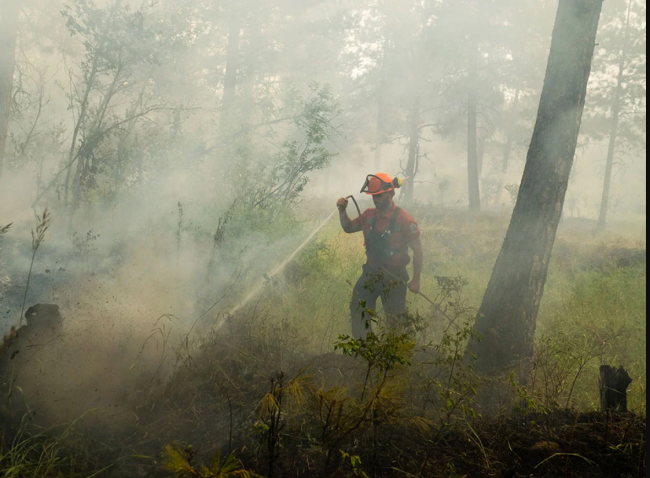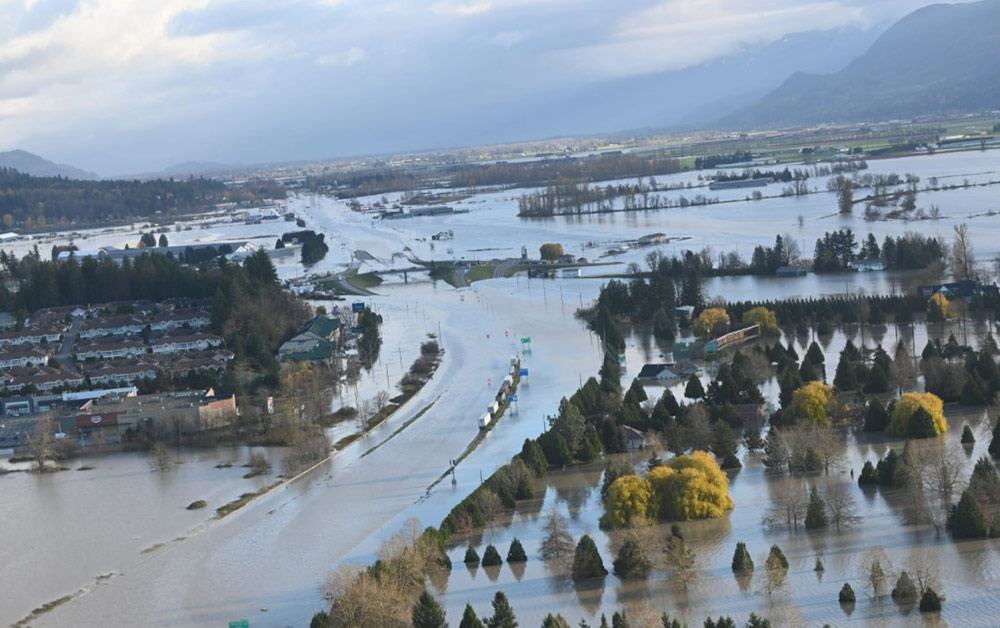Articles Menu

Feb. 28, 2024
After a record-breaking drought and fire season, this month’s B.C. budget made sizable investments in emergency response.
But experts say the focus on response is accompanied by a lack of measures to address the root causes of the disasters.
“We have too many provincial officials with their heads stuck in the mud from floods and their heads stuck in the ash of forest fires,” said Sto:lo Tribal Chief Tyrone McNeil, chair of the Emergency Planning Secretariat, a collaboration of 31 Coast Salish communities to improve emergency planning and preparedness.
“I don’t see anything in the budget that speaks to resilience. It’s all about protection,” said McNeil. “That’s the old way of thinking about emergencies.”
The budget increased the Ministry of Emergency Management and Climate Readiness budget by 14.3 per cent this year, to $115.5 million.
The fire prevention budget in the Forests Ministry increased by 3.5 per cent to $47 million and the fire management budget was boosted 15.2 per cent to $235 million.
But it offered no new funding and little mention of its commitments to protect still-intact ecosystems like old-growth forests and to steward watersheds coming under growing strain.
McNeil wants to see dedicated funding to support more strategic, long-term approaches to climate response to take stock of human impacts on the landscape from forestry to water infrastructure like dikes.
Sarah Korpan, legislative affairs specialist for Ecojustice, wanted to see those measures reflected in this year’s budget.
“There’s no nod to the importance of keeping nature intact through protection stewardship and restoration, and there’s no nod to that being a well-known tool for mitigating climate disasters,” she said.
Finance Minister Katrine Conroy said “one of the big issues for the province of what we’re looking at when it comes to climate changes is the wildfires.”
“We need to be doing that work now. Because I do not want to see another forest fire season like we had last year.”
The new reality
Two-thirds of B.C. water basins were under “extreme drought” levels last year, leaving streams parched and salmon struggling to survive.
And this year they face similar conditions: snow levels are around 40 per cent below normal across B.C. “I am really worried about the summer that’s coming up,” said Premier David Eby earlier in February.
The budget made some targeted investments to address urgent drought issues, including $14 million to restore a 1950s-era weir in Cowichan Lake and $83 million for infrastructure to store and supply water for agriculture. It also allocated $50 million for a water metering pilot program and upgrades to water storage systems on Saltspring Island and the Barrowtown pump station in Abbotsford.
Those are all positive steps, said Oliver Brandes, co-director of the POLIS Water Sustainability Project at the University of Victoria, but they don’t address some of the bigger, more complex decisions ahead about how to manage land to prevent drought and allocate increasingly scarce water resources.
Droughts are “not just random acts of nature,” he said. “They are part of the new reality. We have to move from this reactive mode to something that’s much more proactive.”
Brandes said B.C. has already made strides in that direction, including the 2016 Water Sustainability Act, which paves the way for objectives and thresholds for healthy watersheds. It also includes a coming watershed security strategy that commits to an Indigenous-led and more localized approach to watershed governance. Last year the province put $100 million into the Watershed Security Fund to support local watershed boards to realize the strategy.
So far, Brandes said, only one board has been established in the Koksilah watershed in Cowichan Valley, in partnership with the Cowichan Tribes First Nation and the Cowichan Valley Regional District.
In this year’s budget, Brandes wanted to see more resources to expand the fund and the work it can do.
“One would hope the next budget is going to have to begin to execute some of this,” he said.

B.C. is also due to unveil its flood strategy, which aims to expand B.C.’s approach to flood prevention while recognizing Indigenous rights and jurisdiction.
“Resilience and nature-based solutions are the priority,” said McNeil, who has helped lead the development of the strategy with the Ministry of Water, Land and Resource Stewardship. “We need to take a long-term response to where the climate is going as opposed to these gap-stop measures of building pumps and dikes up higher.”
He said that might mean opening up some waterways, letting them “breathe” instead of building more infrastructure, and making collective decisions about watersheds and the forests surrounding them.
When forests’ soils and root structures are healthy they can act like a sponge, helping to regulate influxes of water when they come.
“When we’re talking about flood, we have to look at it from a watershed perspective, not site-specific area,” said McNeil. “Forest practices are directly related to that.”
Alongside its commitments to rethink watersheds, B.C. has announced a cascade of processes and reforms to transform its approach to managing old-growth forests and other at-risk ecosystems. That includes its commitment to protect 30 per cent of its lands and waters by 2030, signed in partnership with the federal government and the First Nations Leadership Council.
That 30 per cent goal isn’t random: protecting around 70 per cent of ecosystems’ natural composition keeps them within the “low-risk” range. But dipping below 30 per cent puts them at high risk of ecological collapse.
For over a century the B.C. government prioritized its resource-dependent economy over ecosystem health, but in recent years the province has signalled a shift in its approach. Over three years ago, it adopted all 14 recommendations from its Old Growth Strategic Review Panel, which set out a plan for a “paradigm shift” to prioritize ecosystem health and protect the province’s remaining at-risk old-growth forests.
To facilitate the long-running shift, the review panel recommended the province establish temporary logging deferrals in the most at-risk old-growth forests. Today some deferrals have been set aside, but others have since been logged and some remain at risk.
Last fall, B.C. announced its Biodiversity and Ecosystem Health Framework, committing to prioritize the health of ecosystems through coming laws and ecosystem-based targets.
It has also committed to a new era of land-use planning to realize those targets.
But B.C.’s throne speech made no mention of these commitments and the budget provided no explicit additional funding to implement them.
“It’s clear that you actually do need money to implement new changes in law and reform,” said Charlotte Dawe, conservation and policy campaigner for the Wilderness Committee. “It is concerning for us.”
B.C. still has a long way to go: depending on how protected areas are tallied, B.C. has currently protected around 15 per cent of its land mass, and some ecosystems are at high risk.
Last fall the province announced $1.2 billion in funding to support various protection initiatives, including Indigenous Protected And Conserved Areas. For Ken Wu, executive director of the Endangered Ecosystems Alliance, that funding will continue to support the work ahead.
But Wu wanted to see other budget commitments to address the economic impacts of meeting B.C.’s protection targets.
That includes additional funding to support the transition away from old-growth logging to second-growth, like the BC Manufacturing Jobs Fund, launched in 2023.
“I was hoping that they were going to bolster that initiative,” he said.
The province’s 2024 budget allocated $60 million for the Forest Enhancement Society of BC to carry out wildfire mitigation treatments like thinning forests around communities.
BC Assembly of First Nations Regional Chief Terry Teegee said he wants to see more resources for First Nations dealing with the ongoing consequences of climate-related disasters, including wildfire-proofing homes in communities. “For every dollar you spend on preparation you save six bucks,” he said. “That’s well-used money for down the road.”
But Teegee wants to see nations’ rights upheld to guide that work. “Does it truly permit First Nations to implement that United Nations declaration and truly assert their sovereignty and governance of emergencies?” he said.
Teegee added that he wanted to see a greater commitment in B.C.’s budget to revenue sharing for First Nations for resource activity on their territories, and a commitment to fully include nations in the decision-making process about the projects that go through. “In the end, it does come down to how decisions are made,” he said.
In an emailed statement, the BC Council of Forest Industries said it welcomed the budget’s investments in forestry-related wildfire prevention but remained concerned about declining harvest levels and the wave of mill closures that have followed, and is meeting with the government to “stabilize” the industry’s access to trees in the province.
Besides funding commitments, Wu is concerned about an overall silence in the 2024 budget and throne speech on old-growth and ecosystem protection. “A budget is not just a budget,” he said. “It lays out the government’s priorities and their direction.”
“It’s disappointing,” he said.
“We know more floods are coming,” said Tyrone McNeil in a release from the Lower Fraser Floodplains Coalition. McNeil is involved in dozens of initiatives around climate resilience and emergency management.
He sees opportunities to bring them together.
“The last month I’ve been really demanding that B.C. and Canada sit back and get their ducks in order,” he said. “That’ll make things more streamlined and efficient, and it’ll also grow the funding pot.
“Let’s be more strategic about it.”
[Top photo: The province isn’t doing enough to reduce the threat of wildfire by protecting ecosystems, say some experts. Photo by Ben Westerik via BC Wildfire Service.]